Trees of the Adirondacks:
Mountain Maple (Acer spicatum)
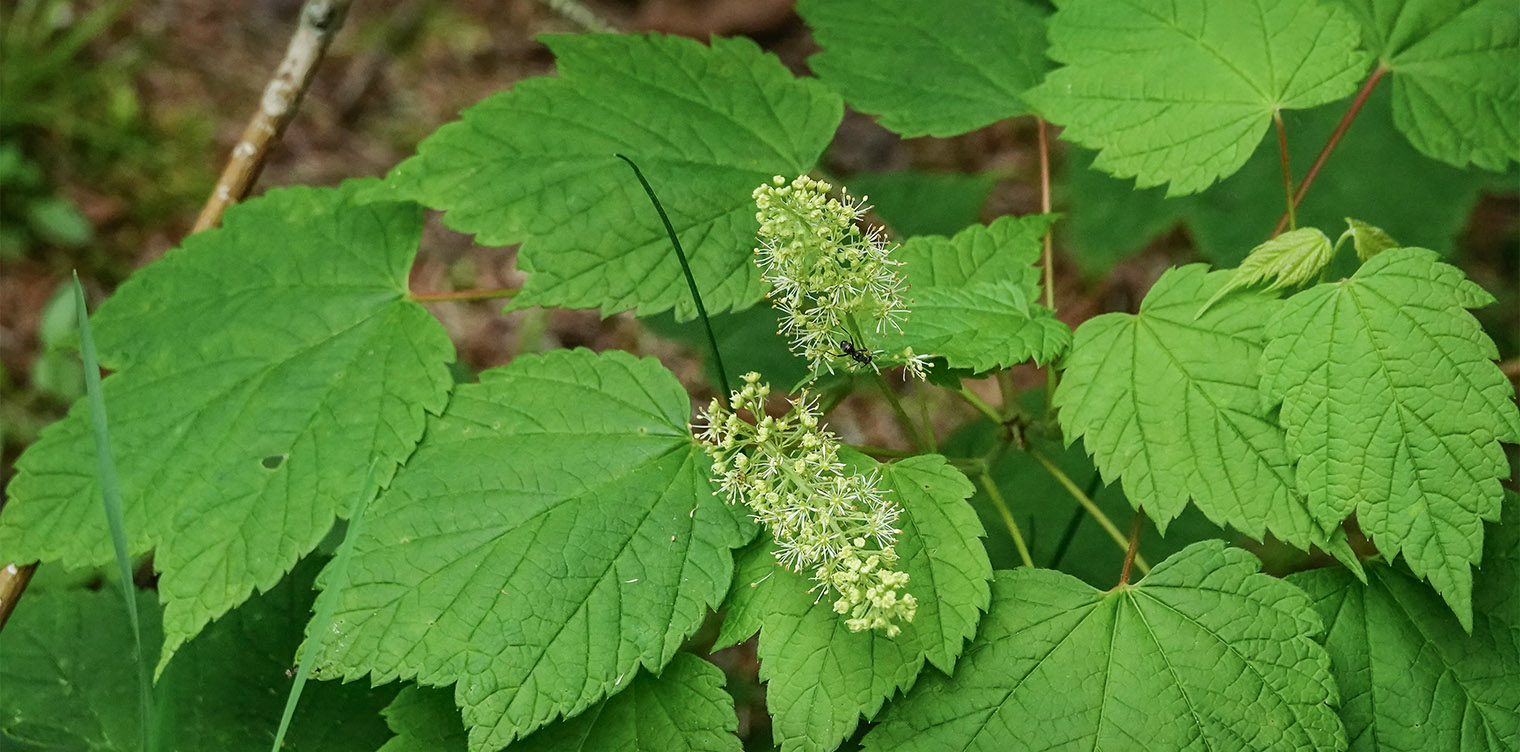
Mountain Maple (Acer spicatum) is a shrub-like tree with three-lobed, coarsely toothed leaves. Its upright greenish-yellow flowers bloom in June in the Adirondack Mountains of upstate New York.
Mountain Maple is one of 14 maple species in New York State. Nine of these (including Mountain Maple) occur in counties that fall within the Adirondack Park. In addition to Mountain Maple, the most common maples found inside the Blue Line are:
- Striped Maple (Acer pensylvanicum)
- Red Maple (Acer rubrum var. rubrum)
- Sugar Maple (Acer saccharum)
- Silver Maple (Acer saccharinum).
The genus name (Acer) is the Latin word for "maple." The species name (spicatum) means "spike-bearing." This is a reference to the spike-like flower clusters that appear after the leaves are fully formed.
Other common names for Mountain Maple include Low Maple, Water Maple, and Eastern Mountain Maple. Mountain Maple may also be referred to as Moose Maple – a reference to the plant's use as a winter browse by Moose. The author name (Lamarck) is a reference to French biologist Jean-Baptiste Lamarck, who died in 1829.
Identification of Mountain Maple
Mountain Maple is a deciduous understory tree, which is sometimes classified as a shrub. It grows ten to twenty feet tall. Mountain Maple has a short, crooked trunk, often branching near the base into several ascending branches, and a small, rounded crown. The bark is reddish to brown. The root system is shallow.
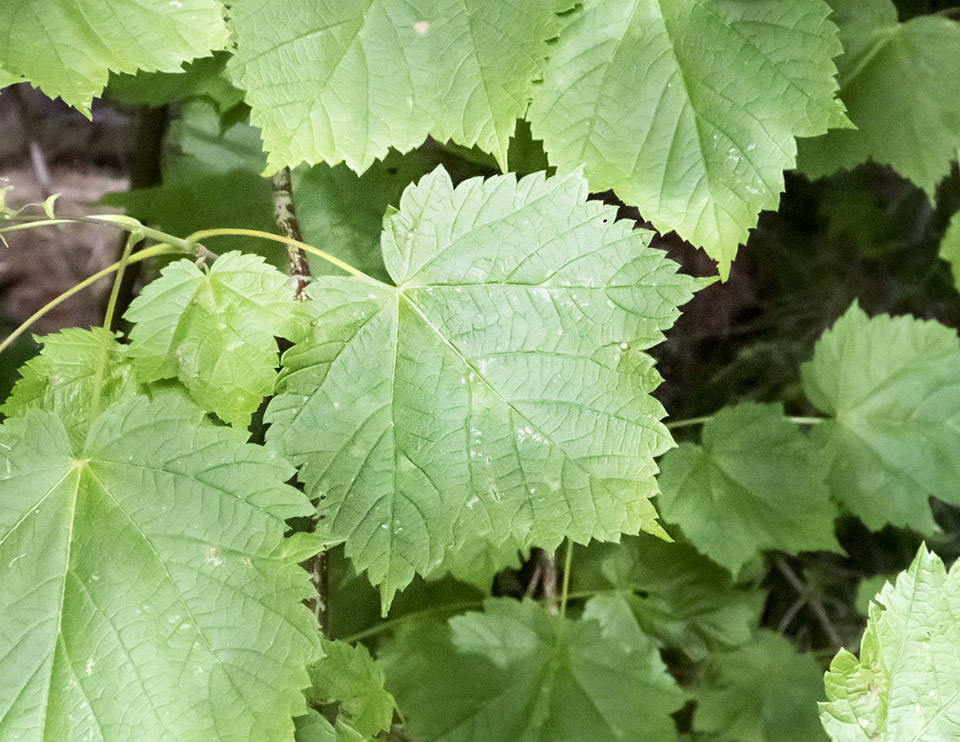
Mountain Maple leaves are simple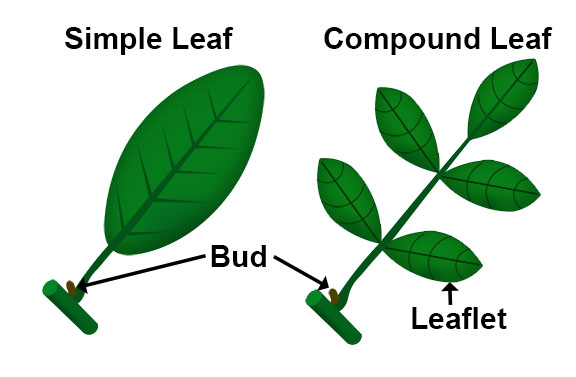 Simple Leaf: A leaf with a single undivided blade, as opposed to a compound leaf, which is one that is divided to the midrib, with distinct, expanded portions called leaflets., meaning that they are not separated into leaflets.
Simple Leaf: A leaf with a single undivided blade, as opposed to a compound leaf, which is one that is divided to the midrib, with distinct, expanded portions called leaflets., meaning that they are not separated into leaflets.
- The leaves are opposite
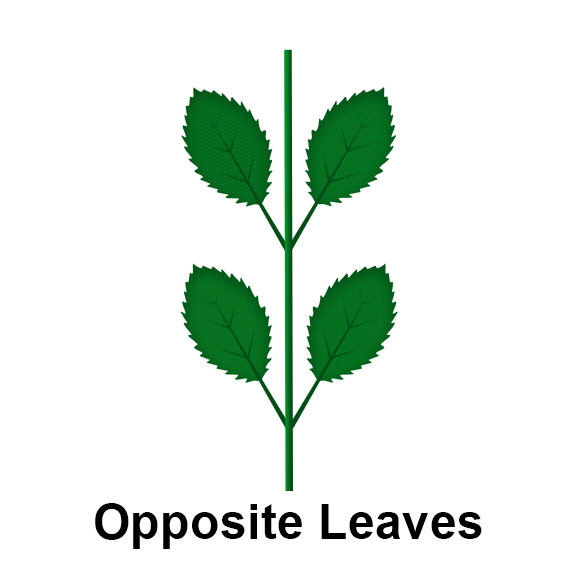 Opposite Leaves: Leaves occurring in pairs at a node, with one leaf on either side of the stem., meaning that there are two leaves per node along the stem.
Opposite Leaves: Leaves occurring in pairs at a node, with one leaf on either side of the stem., meaning that there are two leaves per node along the stem. - The leaf blade
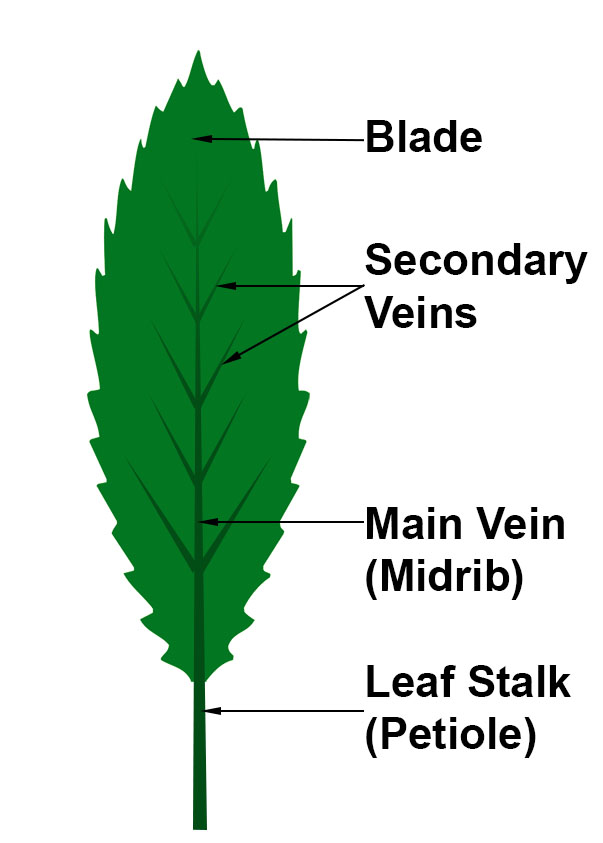 Blade: The broad, flat portion of a leaf, where photosynthesis occurs. is 2¾ to 3½ inches long and nearly as wide. Mountain Maple leaves have three (occasionally five) lobes
Blade: The broad, flat portion of a leaf, where photosynthesis occurs. is 2¾ to 3½ inches long and nearly as wide. Mountain Maple leaves have three (occasionally five) lobes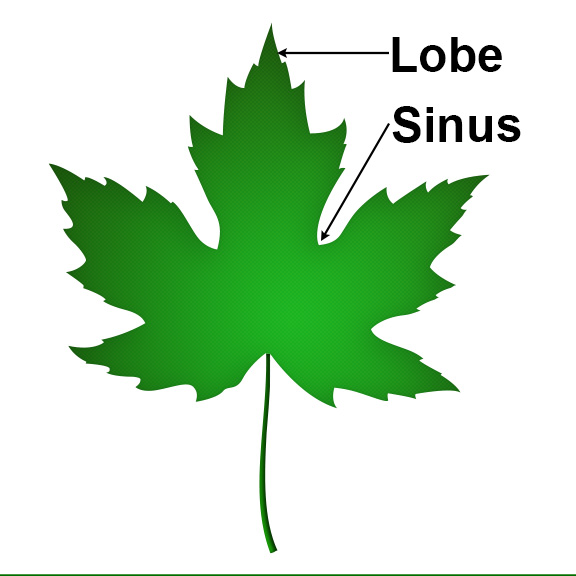 Lobe: A projection from an edge of a plant structure (such as a leaf), larger than a tooth. Lobed leaves are leaves with distinct protrusions, either rounded or pointed. and coarse teeth
Lobe: A projection from an edge of a plant structure (such as a leaf), larger than a tooth. Lobed leaves are leaves with distinct protrusions, either rounded or pointed. and coarse teeth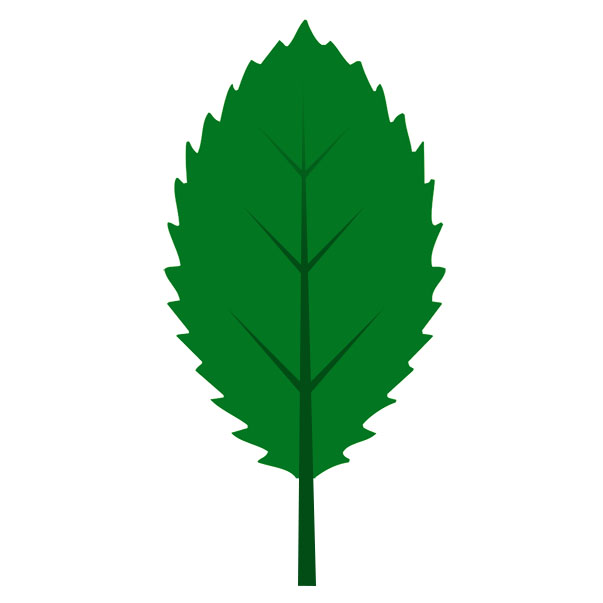 Teeth: The saw-toothed edges of a leaf.. The lobes are broad, with shallow, broadly v-shaped sinuses
Teeth: The saw-toothed edges of a leaf.. The lobes are broad, with shallow, broadly v-shaped sinuses Sinus: In leaves with lobes, the indented area between two lobes. (the notch between the lobes). The base of the leaf is rounded to heart-shaped.
Sinus: In leaves with lobes, the indented area between two lobes. (the notch between the lobes). The base of the leaf is rounded to heart-shaped. - Mountain Maple leaves are green and hairless above. The thin, somewhat papery leaves have a network of delicate veins
 Vein: A vessel that conducts nutrients, sugars, and other substances throughout plant tissues; usually associated with leaves. The arrangement of veins in a leaf is called the venation pattern. which give the leaf a somewhat quilted appearance. The lower surface of the leaves is paler and usually covered with soft, whitish hairs. The foliage turns yellow, then mottled orange, reddish orange, or bright red in autumn.
Vein: A vessel that conducts nutrients, sugars, and other substances throughout plant tissues; usually associated with leaves. The arrangement of veins in a leaf is called the venation pattern. which give the leaf a somewhat quilted appearance. The lower surface of the leaves is paler and usually covered with soft, whitish hairs. The foliage turns yellow, then mottled orange, reddish orange, or bright red in autumn. - The stalk of the leaf is two to three inches long, often red.
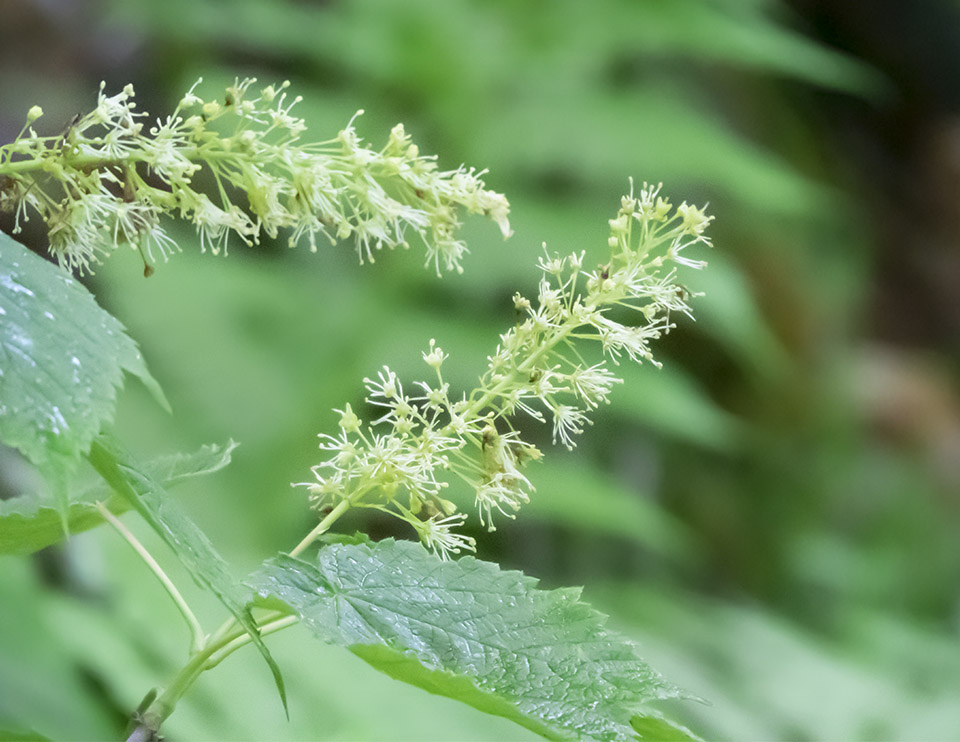
Mountain Maple flowers are greenish-white to yellow. They appear after the leaves are fully developed.
The flowers appear in an erect, terminal cluster, with male flowers near the tip and female flowers near the base. The flower cluster (inflorescence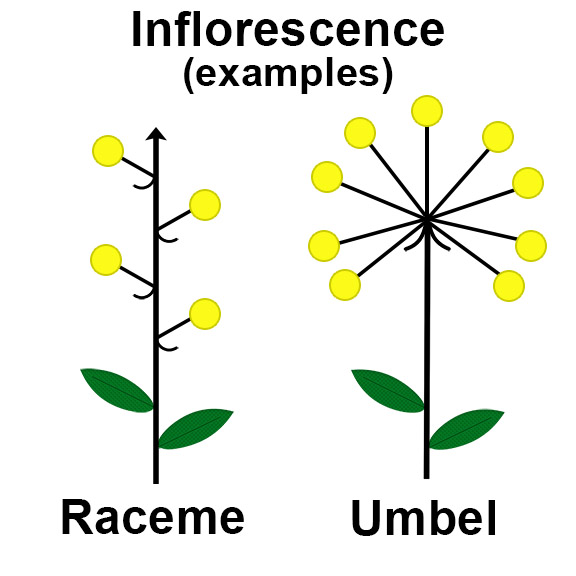 Inflorescence: A group or cluster of flowers arranged on a stem.
) is a panicle
Inflorescence: A group or cluster of flowers arranged on a stem.
) is a panicle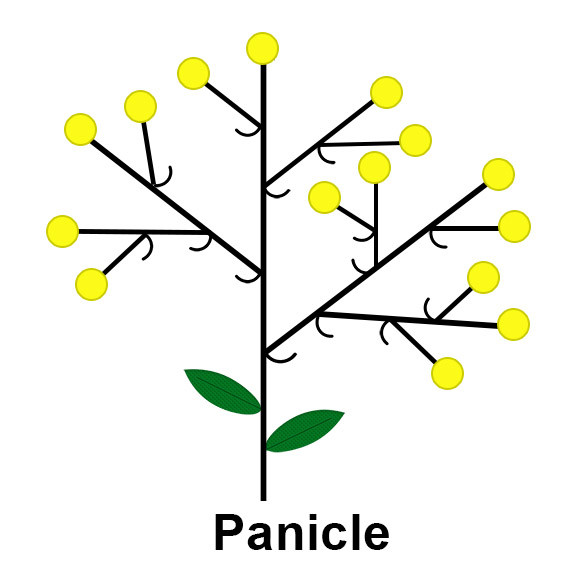 Panicle: A branched, indeterminate flower cluster (inflorescence) with individual flowers on stalks (pedicels). (meaning a flower cluster that is branched with the individual flowers on stalks). The cluster is 1½ to 3 inches tall and an inch or more wide.
Panicle: A branched, indeterminate flower cluster (inflorescence) with individual flowers on stalks (pedicels). (meaning a flower cluster that is branched with the individual flowers on stalks). The cluster is 1½ to 3 inches tall and an inch or more wide.
Individual flowers are about ¼ to ½ inches across. The flower stalks are ¼ to ⅜ inches long and hairy.
In the High Peaks region of the Adirondacks, Mountain Maple trees usually bloom in mid- to late June. Mountain Maples in the eastern foothills of the Adirondacks bloom somewhat earlier, in late May, while Mountain Maple trees just southeast of the Blue Line may be seen in bloom in mid-May.
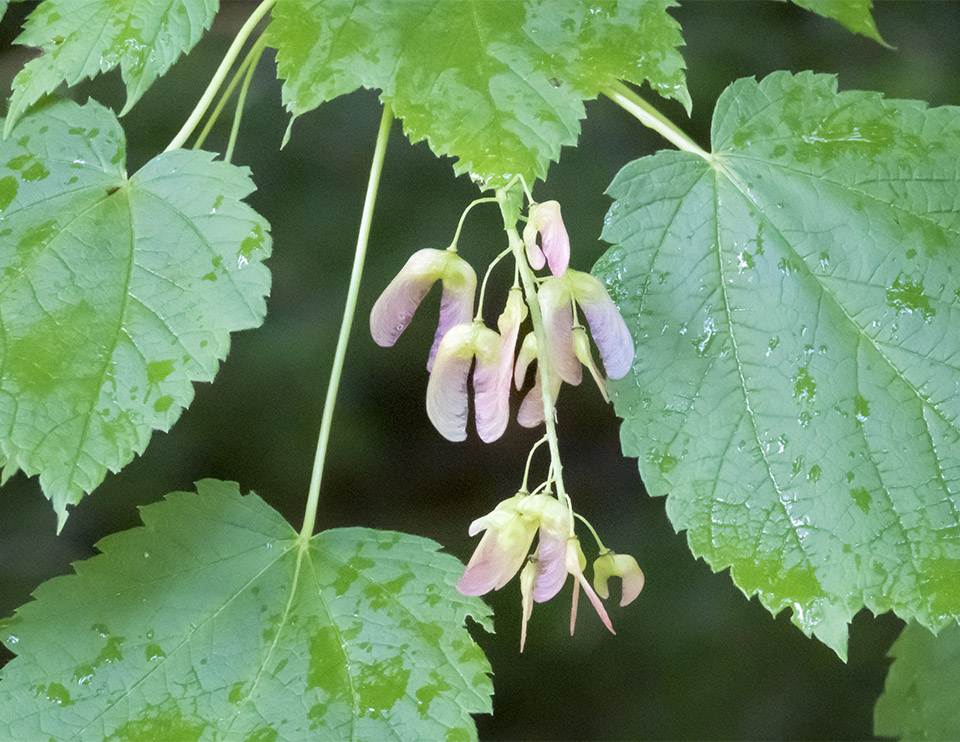
The fruit of Mountain Maples is a pair of winged seeds (called a samara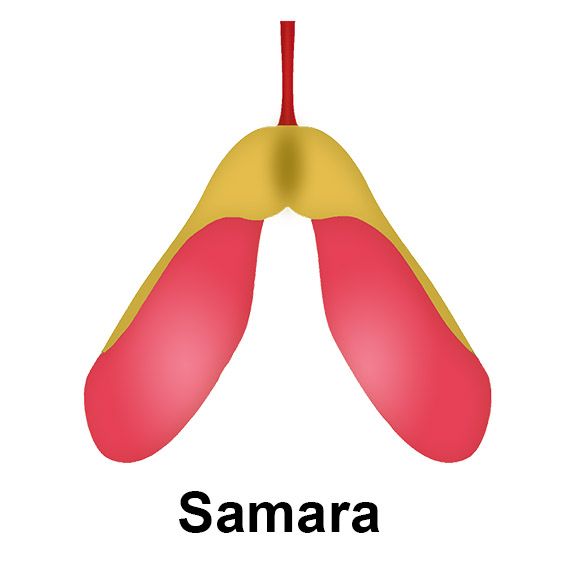 Samara: A type of dry fruit where one seed is surrounded by papery tissue that helps carry the seed away from the tree as the wind blows.
). Mountain Maple samaras are typically ¾ to an inch long on short stalks and appear in drooping clusters. The winged seeds are often pink or rosy red, later turning yellow, then brown, before falling in early winter. In the Adirondacks, look for Mountain Maple in fruit starting in July.
Samara: A type of dry fruit where one seed is surrounded by papery tissue that helps carry the seed away from the tree as the wind blows.
). Mountain Maple samaras are typically ¾ to an inch long on short stalks and appear in drooping clusters. The winged seeds are often pink or rosy red, later turning yellow, then brown, before falling in early winter. In the Adirondacks, look for Mountain Maple in fruit starting in July.
Keys to identifying Mountain Maple and differentiating it from other maples include its growth habit, the shape of its leaves, the arrangement of its flowers, and its bark.
- Mountain Maple can be distinguished from Sugar Maple by the shape of its leaves. Sugar Maple leaves have five lobes, and the edges are smooth between the points, in contrast to Mountain Maple's coarse teeth. Sugar Maple flowers appear in drooping clusters, rather than the upright clusters of Mountain Maple. The growth habit is very different. Sugar Maples are large trees growing growing 50-70 feet tall, with a straight, single trunk, while Mountain Maples are short, shrubby plants.
- Like Mountain Maple, Red Maple leaves are also coarsely toothed and have three major lobes, sometimes with two smaller lobes near the base. However, Red Maple's lobes are narrowly pointed and the sinuses
 Sinus: In leaves with lobes, the indented area between two lobes. (the notches between the lobes) are V-shaped. In addition, Red Maple's flowers are red and appear before the leaves appear, contrasting with Mountain Maples yellowish flowers which appear after the leaves have developed. Moreover, like the Sugar Maple, the Red Maple is a large tree growing up to 90 feet tall, in contrast to Mountain Maple's shrubby growth habit.
Sinus: In leaves with lobes, the indented area between two lobes. (the notches between the lobes) are V-shaped. In addition, Red Maple's flowers are red and appear before the leaves appear, contrasting with Mountain Maples yellowish flowers which appear after the leaves have developed. Moreover, like the Sugar Maple, the Red Maple is a large tree growing up to 90 feet tall, in contrast to Mountain Maple's shrubby growth habit.
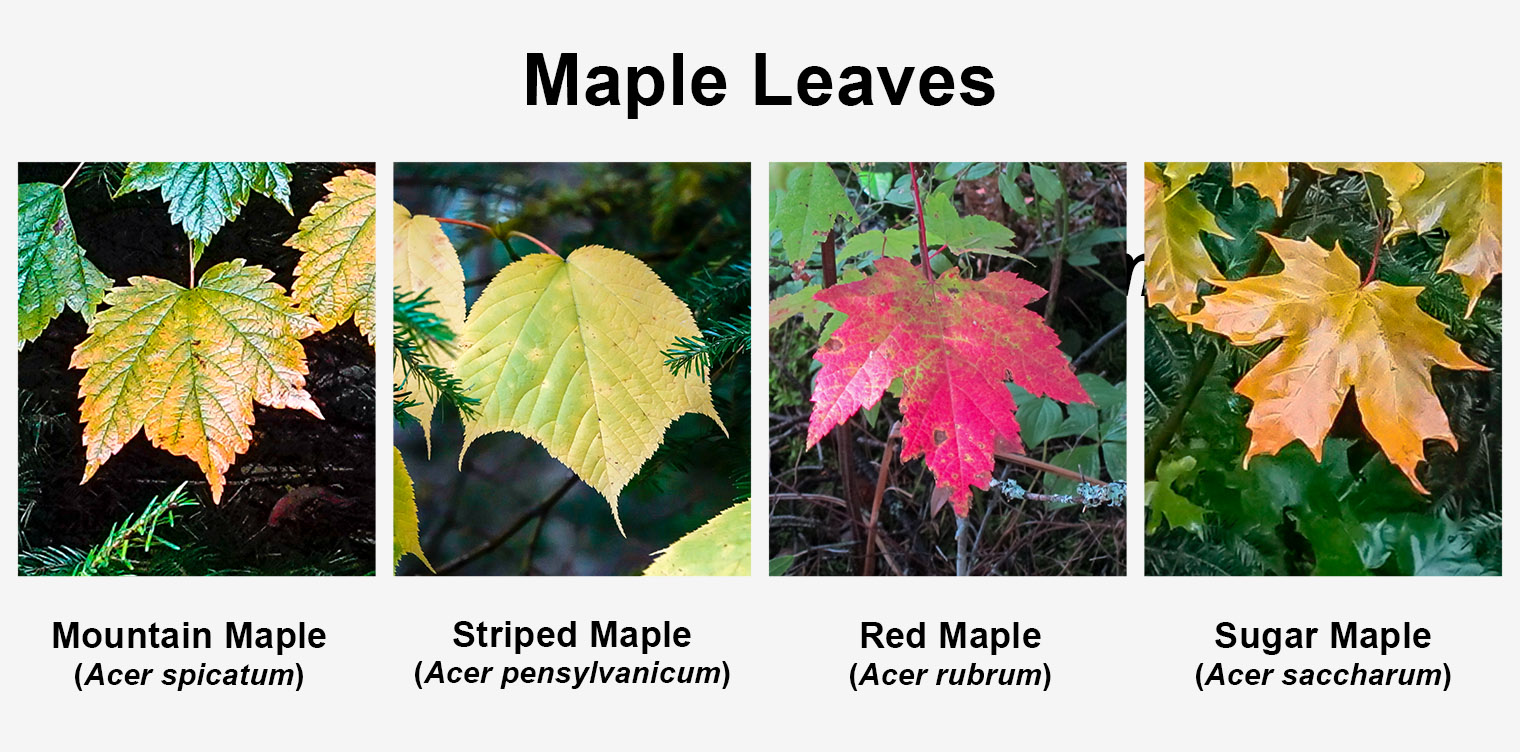
The plant most likely to be confused with Mountain Maple is the Striped Maple.
- Both are understory trees or large shrubs.
- Both have three-lobed leaves which are more shallowly lobed than those of either Red Maple or Sugar Maple. Striped Maple leaves, however, are finely double-toothed, while the leaves of Mountain Maple (which tend to be somewhat smaller) have coarse teeth.
- The bark is another clue. The bark of the Striped Maple is greenish with distinctive white stripes when the tree is young, contrasting with the darker bark of Mountain Maple.
Uses of Mountain Maple
Mountain Maple has limited uses. The wood is of no economic value and is not used commercially. Native Americans used this plant to treat several medical conditions, including coughs, sore eyes, and wounds. The wood was also used to make arrows.
Wildlife Value of Mountain Maple
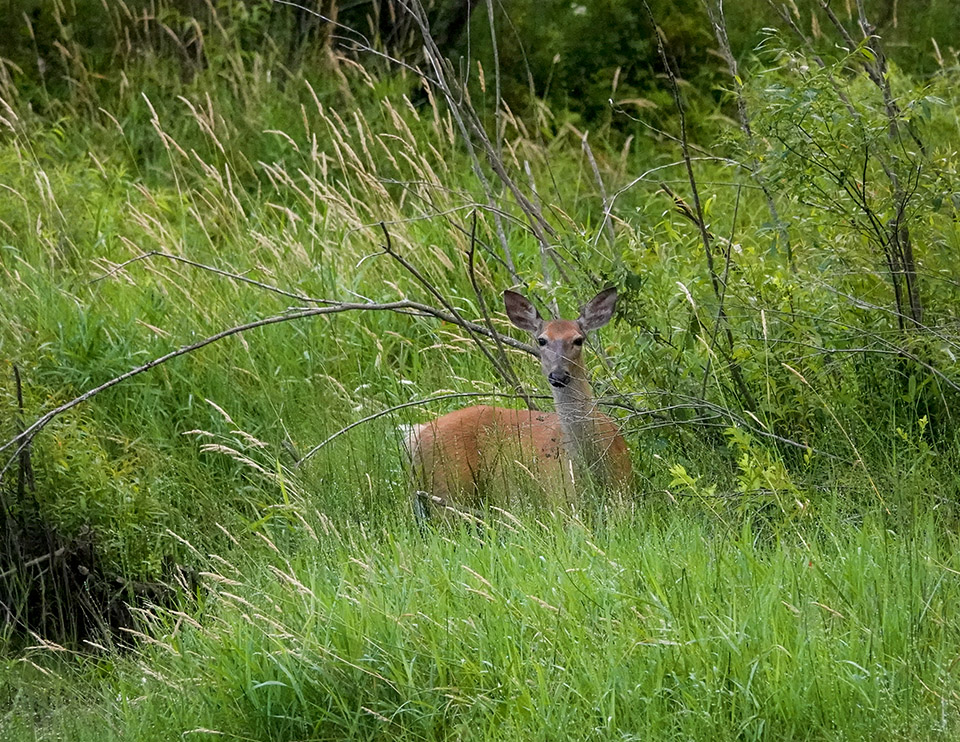
Mountain Maple is important as a browse for several mammal species. Mountain Maple is listed by the New York State Department of Environmental Conservation as a preferred winter food for White-tailed deer (Odocoileus virginianus), based on thousands of observations in deer wintering areas over many years from all parts of the state.
Mountain Maple is also used, although apparently to a lesser extent, by Moose (Alces alces). American Beaver (Castor canadensis) are also said to browse on the plant when aspens are not available.
Mountain Maple is of lesser importance for birds and insects. Ruffed Grouse reportedly eat the buds, while the plant is used as a nest site by Black-throated Blue Warblers. Some species of beetles and aphids also make use of the plant.
Distribution of Mountain Maple
Mountain Maple grows in the eastern regions of the US and Canada. This plant occurs from Newfoundland to Saskatchewan in Canada, south to Connecticut, Ohio, Michigan, and northern Iowa, and in the mountains to western North Carolina and eastern Tennessee.
In New York State, Mountain Maple has been documented in almost all counties in the eastern half of the state. It is found in all counties within the Adirondack Park Blue Line.
Habitat of Mountain Maple
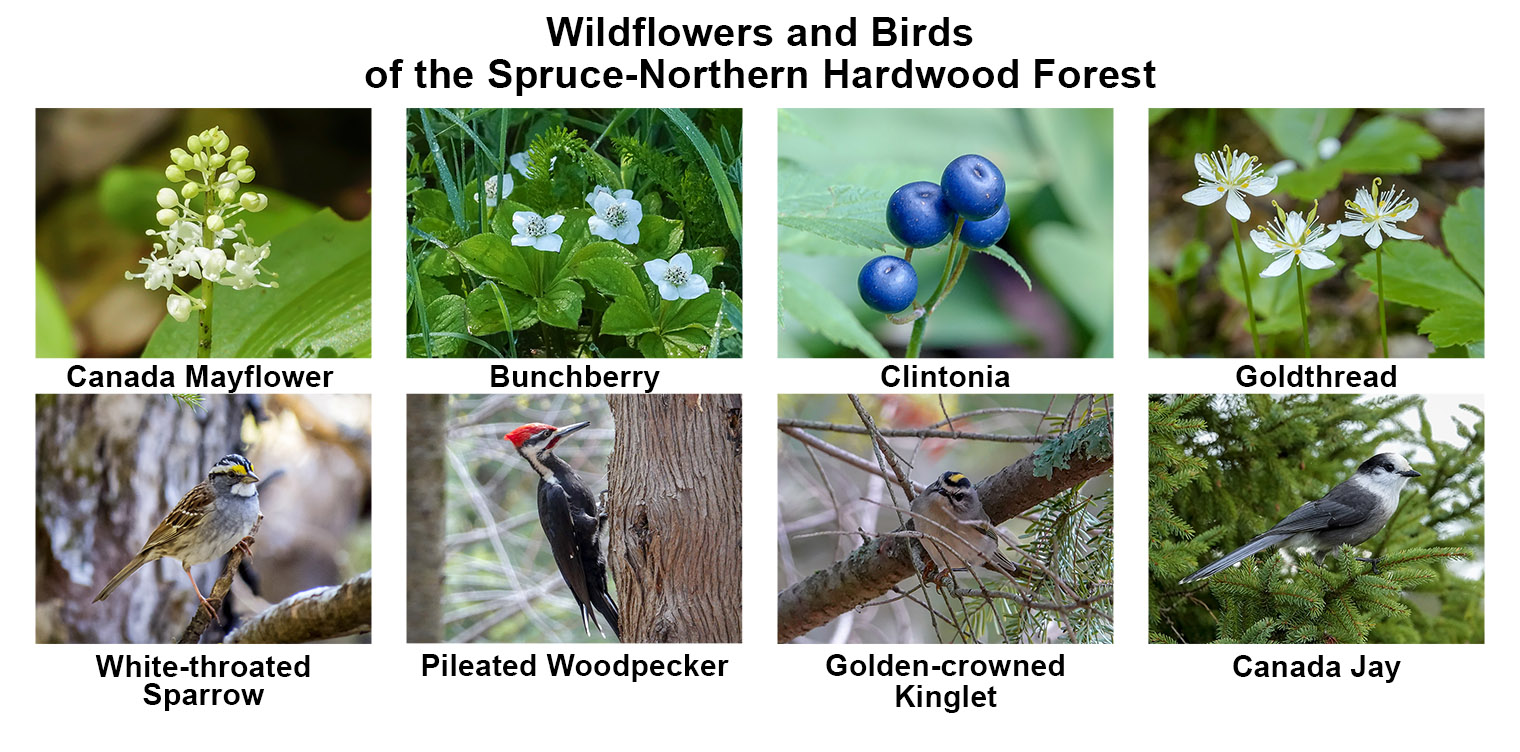
Mountain Maple is classified as a facultative upland plant (FACU), meaning that it usually occurs in nonwetlands, but may also occur in wetlands. It is found in hardwood, mixed wood, and mountain conifer forests. This species has medium moisture and nutrient requirements, and low heat and light requirements. It is our least shade-tolerant maple. It can tolerate strong sunlight better than Striped Maple. Mountain Maple prefers rich, moist soils on rocky slopes and flats, but can also grow well on drier or well-drained acid soils.
Mountain Maple is common on exposed ledges and steep slopes and along streams. It is a common understory tree between 2,500 and 3,000 feet in the transition zone between northern hardwoods and spruce-fir.
In the Adirondack region, Mountain Maples are found in several ecological communities, including:
For example, Mountain Maple is a common understory tree in the Spruce-Northern Hardwood Forest – a mixed forest which is one of the most common forest types in the Adirondack Park.
- Co-dominant trees are Red Spruce, Sugar Maple, American Beech, Red Maple and Yellow Birch. Scattered Balsam Fir is also found.
- Another common sub-canopy tree in this ecological community, often found growing near Mountain Maple, is the Striped Maple.
- Characteristic shrubs include Hobblebush, Canada Yew, and American Fly Honeysuckle.
- On the forest floor, look for Common Wood Sorrel, Wild Sarsaparilla, Goldthread, Clintonia, Bunchberry, Canada Mayflower, and Indian Cucumber-root. Characteristic ferns include the Intermediate Wood Fern and the Hay-scented Fern.
- Characteristic birds include Yellow-bellied Flycatcher, White-throated Sparrow, Golden-crowned Kinglet, Pileated Woodpecker, and Canada Jay.
Adirondack Tree List
References
Michael Kudish. Adirondack Upland Flora: An Ecological Perspective (The Chauncy Press, 1992), p. 173.
Edwin H. Ketledge, "The Maples of New York," New York State Conservationist, Volume 16, Number 5 (April-May 1962), pp. 31-32. Retrieved 21 September 2020.
New York Flora Association. New York Flora Atlas. Mountain Maple. Acer spicatum Lam. Retrieved 20 March 2018.
New York Flora Association. New York Flora Atlas. Acer. Retrieved 20 March 2018.
Integrated Taxonomic Information System. Acer spicatum Lam. Retrieved 20 March 2018.
J. T. Kartesz. The Biota of North America Program (BONAP). 2015. Taxonomic Data Center. Chapel Hill, N.C. Acer spicatum. Retrieved 20 March 2018.
United States Department of Agriculture. The Plants Database. Mountain Maple. Acer spicatum Lam. Retrieved 20 March 2018.
United States Department of Agriculture. Fire Effects Information System (FEIS). Species Reviews. Acer spicatum. Retrieved 20 March 2018.
Paul E. Hosier, "Mountain Maple," in John D. Gill and William M. Healy, eds. Shrubs and Vines for Northeastern Wildlife (USDA Forest Service General Technical Report NE-9, 1974), pp. 93-96. Retrieved 4 March 2018.
NatureServe Explorer. Online Encyclopedia of Life. Mountain Maple. Acer spicatum - Lam. Retrieved 21 March 2018.
Northern Forest Atlas. Images. Acer spicatum. Mountain Maple. Retrieved 21 March 2018.
Margaret B. Gargiullo. A Guide to Native Plants of the New York City Region (New York City Department of Parks & Recreation, 2007), p. 3.
Native Plant Trust. Go Botany. Mountain Maple. Acer spicatum Lam. Retrieved 15 November 2019.
New York State. Department of Environmental Conservation. New York Natural Heritage Program. Ecological Communities of New York State. Second Edition (March 2014), pp. 120-121, 123-124. Retrieved 17 October 2015.
New York Natural Heritage Program. 2022. Online Conservation Guide for Ice Cave Talus Community. Retrieved 29 March 2022.
New York Natural Heritage Program. 2022. Online Conservation Guide for Maple-Basswood Rich Mesic Forest. Retrieved 29 March 2022.
New York Natural Heritage Program. 2022. Online Conservation Guide for Mountain Spruce-Fir Forest. Retrieved 29 March 2022.
New York Natural Heritage Program. 2022. Online Conservation Guide for Shale Cliff and Talus Community. Retrieved 29 March 2022.
New York Natural Heritage Program. 2022. Online Conservation Guide for Spruce-Northern Hardwood Forest. Retrieved 29 March 2022.
New York State. Adirondack Park Agency. Preliminary List of Species Native Within the Adirondack Park Listed Alphabetically by Scientific Name and Sorted by Habit. Volume 1. Updated 10.23.2006, p. 8. Retrieved 26 January 2017.
USA National Phenology Network. Nature’s Notebook. Acer spicatum. Retrieved 21 March 2018.
Minnesota Wildflowers. Acer spicatum (Mountain Maple). Retrieved 21 March 2018.
Illinois Wildflowers. Vertebrate Animal & Plant Database. Acer spicatum (Mountain Maple). Retrieved 20 March 2018.
Illinois Wildflowers. Insect Visitors of Illinois Wildflowers. Acer spicatum (Mountain Maple). Retrieved 21 March 2018.
Illinois Wildflowers. Plant-Feeding Insect Database. Acer spicatum (Mountain Maple). Retrieved 21 March 2018.
Eloise Butler Wildflower Garden. The Friends of the Wild Flower Garden. Mountain Maple. Acer spicatum Lam. Retrieved 21 March 2018.
Lady Bird Johnson Wildflower Center. Acer spicatum Lam. Retrieved 22 March 2018.
New York State Department of Environmental Conservation. Winter Deer Foods. Retrieved 22 March 2018.
William K. Chapman and Alan E. Bessette. Trees and Shrubs of the Adirondacks: A Field Guide (North Country Books, 1990), p. 92, Plates 20 and 22.
Stan Tekiela. Trees of New York: Field Guide (Adventure Publications, Inc., 2006), pp. 148-149.
May Theilgaard Watts and Tom Watts. Winter Tree Finder: A Manual for Identifying Deciduous Trees in Winter (Nature Study Guild, 1970), pp. 7, 44, 48.
George A. Petrides. A Field Guide to Eastern Trees (Boston: Houghton Mifflin Company, 1998), p. 203.
Gil Nelson, Christopher J. Earle, and Richard Spellenberg. Trees of Eastern North America (Princeton : Princeton University Press), pp. 618, 624-625.
C. Frank Brockman. Trees of North America: A Field Guide to the Major Native and Introduced Species North of Mexico (Golden Press, 1986), pp. 214-215.
R. C. Hosie. Native trees of Canada. 8th Edition (Canada. Department of Forestry and Rural Development, 1979), pp. 278-279. Retrieved 21 March 2018.
John Kricher. A Field Guide to Eastern Forests. North America (Boston: Houghton Mifflin, 1998), pp. 62, 70, 72, 99.
Bruce Kershner, et al. National Wildlife Federation Field Guide to Trees of North America (New York: Sterling Publishing Co., 2008), p. 184.
David Allen Sibley. The Sibley Guide to Trees (New York: Alfred A. Knopf, 2009), p. 345.
William Carey Grimm. The Illustrated Book of Wildflowers and Shrubs (Stackpole Books, 1993), pp. 383-385.
Allen J. Coombes. Trees (Dorling Kindersley, Inc., 1992), p. 103.
Mark J. Twery, et al. Changes in Abundance of Vascular Plants under Varying Silvicultural Systems at the Forest Ecosystem Research and Demonstration Area, Paul Smiths, New York. USDA Forest Service. Research Note NRS-169. Retrieved 22 January 2017, p. 6.
Alexander C. Martin, Herbert S. Zim, and Arnold L. Nelson. American Wildlife & Plants. A Guide to Wildlife Food Habits (Dover Publications, 1951), pp. 339-340.
Donald Culross Peattie. A Natural History of Trees of Eastern and Central North America (Houghton Mifflin Company, 1966), pp. 470-471. Retrieved 4 March 2018.
Plants for a Future. Acer spicatum - Lam. Retrieved 22 March 2018.
University of Michigan. Native American Ethnobotany. A Database of Foods, Drugs, Dyes and Fibers of Native American Peoples, Derived from Plants. Mountain Maple. Acer spicatum Lam. Retrieved 22 March 2018.
The Cornell Lab of Ornithology. Birds of North America. Subscription web site. Black-throated Blue Warbler. Retrieved 22 March 2018.
Nancy G. Slack and Allison W. Bell. Adirondack Alpine Summits: An Ecological Field Guide (Adirondack Mountain Club, Inc., 2006), p. 17.
Charles H. Peck. Plants of North Elba. (Bulletin of the New York State Museum, Volume 6, Number 28, June 1899), p. 85. Retrieved 22 February 2017.
Saratoga Woods and Waterways. A Short Trip to the Adirondacks. 25 May 2017. Retrieved 22 March 2018.
Saratoga Woods and Waterways. On the Hunt for the Missing Plants. 2 July 2016. Retrieved 22 March 2018.
Saratoga Woods and Waterways. Stormy Weather at Pyramid Lake. 30 May 2011. Retrieved 22 March 2018.
Saratoga Woods and Waterways. A Lakeside Walk and a River Paddle. 8 June 2011. Retrieved 22 March 2018.
Saratoga Woods and Waterways. A Great Day for Flower Finds. 16 May 2012. Retrieved 22 March 2018.
Claude Daigle, Michel Crête, Louis Lesage, Jean-Pierre Ouellet, and Jean Huot, "Summer Diet of Two White-tailed Deer, Odocoileus virginianus, Populations Living at Low and High Density in Southern Québec," The Canadian Field-Naturalist, Volume 118, Number 3 (2004), pp. 360-367. Retrieved 22 March 2018.
"Lamarck, Jean Baptiste Antoine Pierre Monnet de," in Taxonomic Literature: A Selective Guide to Botanical Publications and Collections with Dates, Commentaries and Types. Volume 2, p. 730. Retrieved 22 March 2018.
Gary E. Belovsky, "Food Plant Selection by a Generalist Herbivore: The Moose," Ecology, Volume 62, Issue 4 (August 1981), pp. 1020-1030. Retrieved 22 March 2018.
John F. Wetzel, James R. Wambaugh and James M. Peek, "Appraisal of White-Tailed Deer Winter Habitats in Northeastern Minnesota," The Journal of Wildlife Management, Volume 39, Number 1 (January 1975), pp. 59-66. Retrieved 22 March 2018.
Robert G. Routledge and John Roese, "Moose Winter Diet Selection in Central Ontario," Alces, Volume 40 (2004), pp. 95-101. Retrieved 22 March 2018.
Glenn D. Delgiudice, Barry A. Sampson and John H. Giudice, "A Long-Term Assessment of the Effect of Winter Severity on the Food Habits of White-Tailed Deer," The Journal of Wildlife Management, Volume 77, Number 8 (November 2013), pp. 1664-1675. Retrieved 22 March 2018.
Edmund S. Telfer. "Browse Selection by Deer and Hares," The Journal of Wildlife Management, Volume 36, Number 4 (October 1972), pp. 1344-1349. Retrieved 22 March 2018.
